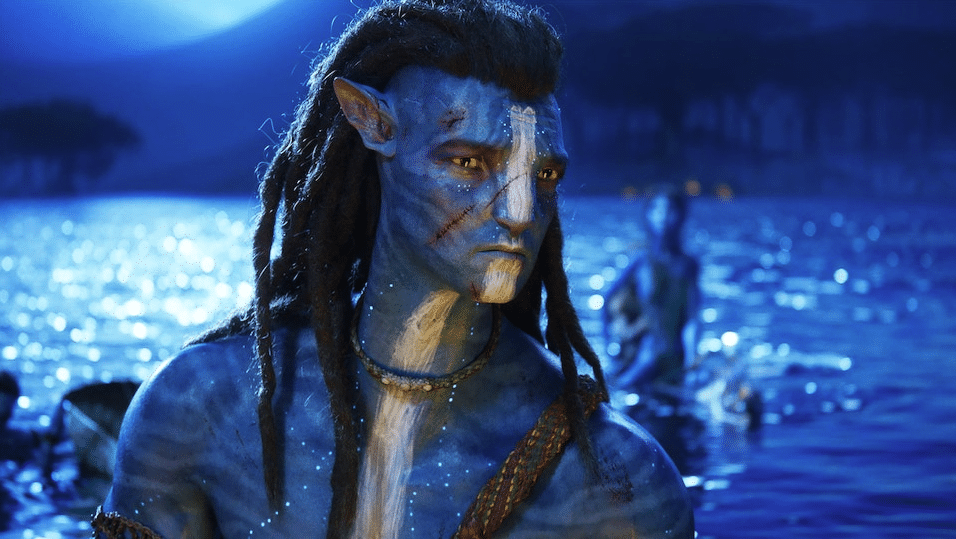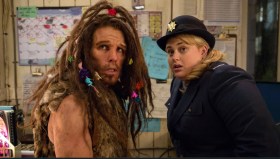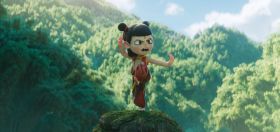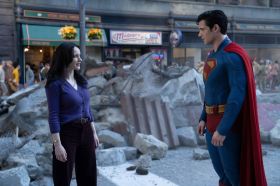The biggest blockbusters aren’t about telling you a story. They’re about taking the audience on a journey – which sounds like marketing-speaking until you realise that’s pretty much the rationale behind roller coaster rides and cheap flights to tourist traps. That’s in no way designed to denigrate the often astonishing visual achievements of Avatar: The Way of Water. Just keep in mind that it’s a movie much more about taking you to an amazing place than telling a sharp and original story.
Former human marine Jake Scully (Sam Worthington), now permanently inhabiting his Na’vi body, has made a life for himself on Pandora. Together with his wife, natural born-Na’vi Neytiri (Zoe Saldaña) they have two sons – Neteyam (Jamie Flatters) and Lo’ak (Britain Dalton) – a daughter, Tuk (Trinity Jo-Li Bliss), and have also adopted Kiri (Sigourney Weaver) who was somehow born from the avatar used by the now deceased Grace (Sigourney Weaver). There’s also human Spider (Jack Champion), who was left behind and is now somewhere between a pet and a mascot.
Then the sky people (aka humans) return, and this time they’re not messing around digging up floating rocks. Earth is dying, and Pandora is earmarked to be humanity’s new home … once they pacify the locals. To help with that, General Ardmore (Edie Falco) has with her a revived Colonel Quaritch (Stephen Lang), who handily had his brain recorded right before he died in the first film. Said recording has been implanted into a Na’vi body, and now he’s out for revenge. As it turns out, he’s not the only one.
Cameron
Writer-director James Cameron is easily Hollywood’s foremost expert when it comes to blockbuster storytelling (sorry Christopher Nolan). So while the underlying narrative isn’t all that inspired and could probably have lost a few cast members, it’s still always coherent and engaging, even across the three hour plus run time.
Avatar: The Way of Water isn’t quite a greatest hits collection, nor is it Cameron taking a victory lap, but there are a lot of callbacks to his earlier work here. If you ever wondered if Titanic would have been better with a lot more fight scenes and gunplay and some robotic exoskeletons, you will get your answer here (and it’s ‘yes’).
Unfortunately, some of Cameron’s flaws tag along for the ride. Even his best films have pacing problems: Terminator 2 may be a relentless thrill ride 80% of the time, but there’s a stretch in the middle where our heroes actually escape the threat – and with it off screen, the tension driving the film fades a little.
And so it proves to be here. In their Na’vi bodies, Quaritch and his jarhead squad of hoo-rah brain transplants don’t trigger the planet’s defences against aliens, making them a real threat to the small-scale but efficient resistance led by Jake. Realising that they won’t stop, Jake and Neytiri decide the only option is to flee, heading out to a scattered collection of islands.
There they hide out with the tattoo’d Metkayina clan led by Tonowari (Cliff Curtis) and wife Ronal (Kate Winslet), who follow The Way of Water and have lighter skin and big Popeye-style forearms.
At that point, the film shifts gears back to the big selling point of the first film: exploring a vividly realised alien world. But where we discovered Pandora’s forest mostly through Jake’s eyes, he (and Quaritch, and definitely Neytiri) are sidelined for a lengthy stretch as exploring this new waterworld is handed over to the children.
Neteyam maybe finds a girlfriend, Lo’ak bonds with a rogue space whale (who, in perhaps the films best twist, is driven by revenge), and Kiri explores her special connection with the planet’s consciousness. Intentionally, this stretch slows things down – this is the part of the film that really shows off the amazing visuals – but it does blunt the film’s forward momentum.
Not that everyone will care, as Cameron constantly ups the ante visually, whether by adjusting the frame rate to heighten the realism, showing off stunningly designed creatures (and human technology), or simply luxuriating in the vividly realised alien world he’s created. Even the grimmer moments – on Pandora whaling is back and Aussie Brandan Cowell is the captain on the ship, with a weirdly US-accented Jemaine Clement as his science officer – are almost documentary-like in their realism.
Cinematography
There are long stretches where nothing you see on screen actually existed, and yet the cinematography, or just the play of light on water, makes this more visually authentic than most live-action films (to be fair, there are also a few moments where the limits of the technology are bumped up against). There’s been a run of underwater-set films lately; this one trumps them all and then some.
The whole cycle of families and vengeance – we haven’t even covered how Spider links to Quaritch, or how Neteyam and Lo’ak are constantly trying to win their father’s approval in ways almost guaranteed to fail – eventually leads to a huge battle at sea that somehow involves a calvary charge on flying seahorses, yet more reminders that humanity really needs to put armoured glass on their helicopter gunships, a vengeance-crazed space whale loping a man’s arm off with a tow cable, and another hour or so’s worth of thrilling action in the unbeatable James Cameron style.
If this is less fully satisfying than the first film, that’s mostly due to it being just one part of a larger whole. Which is pretty much the theme running throughout the film itself. The end tips the story towards full-scale war: with the action sequences here being the clear highlight visually and dramatically, another trip back to Pandora can’t come soon enough.
Avatar: The Way of Water is in cinemas from 15 December.
Actors:
Director:
Format: Movie
Country:
Release:





